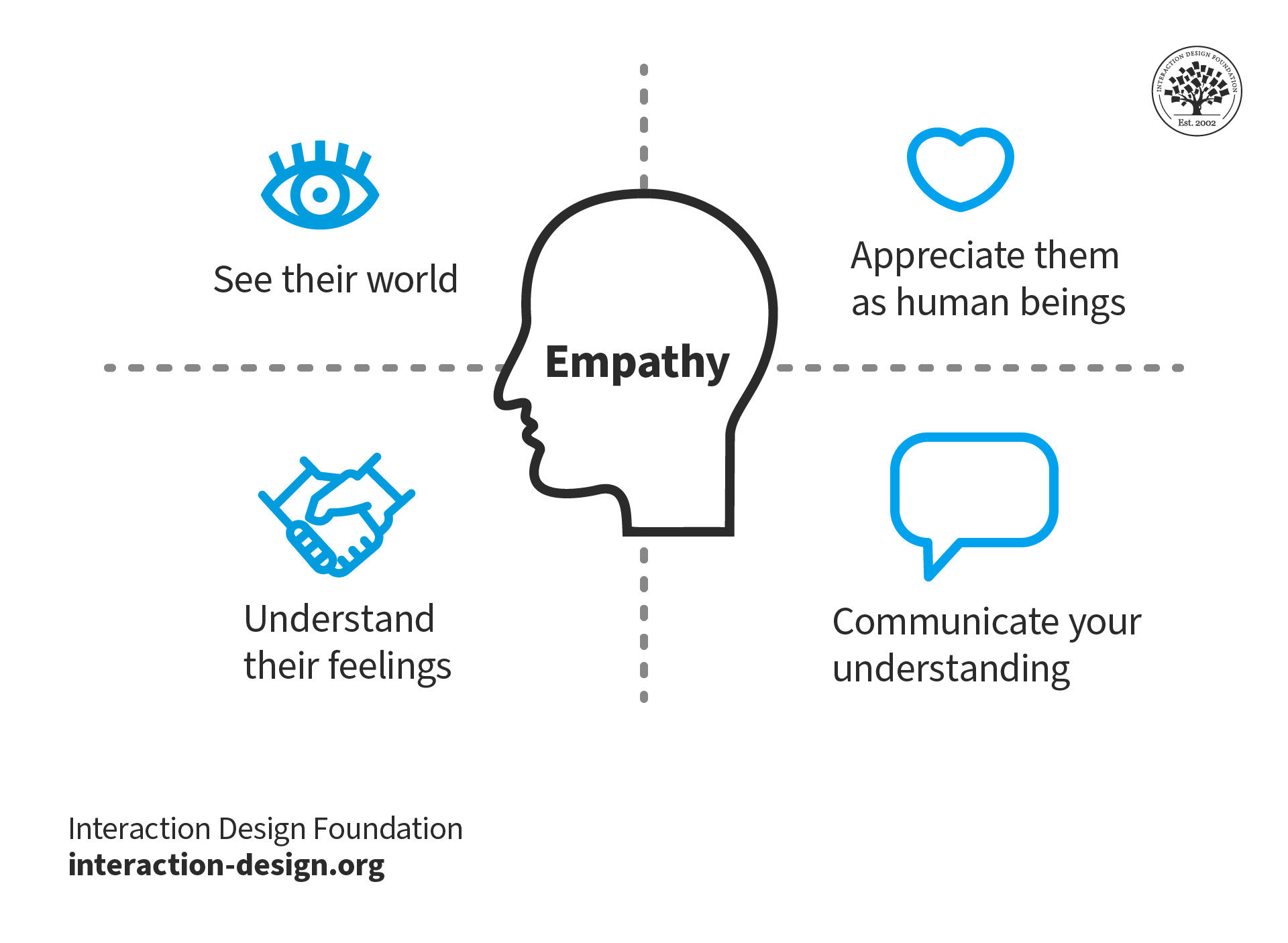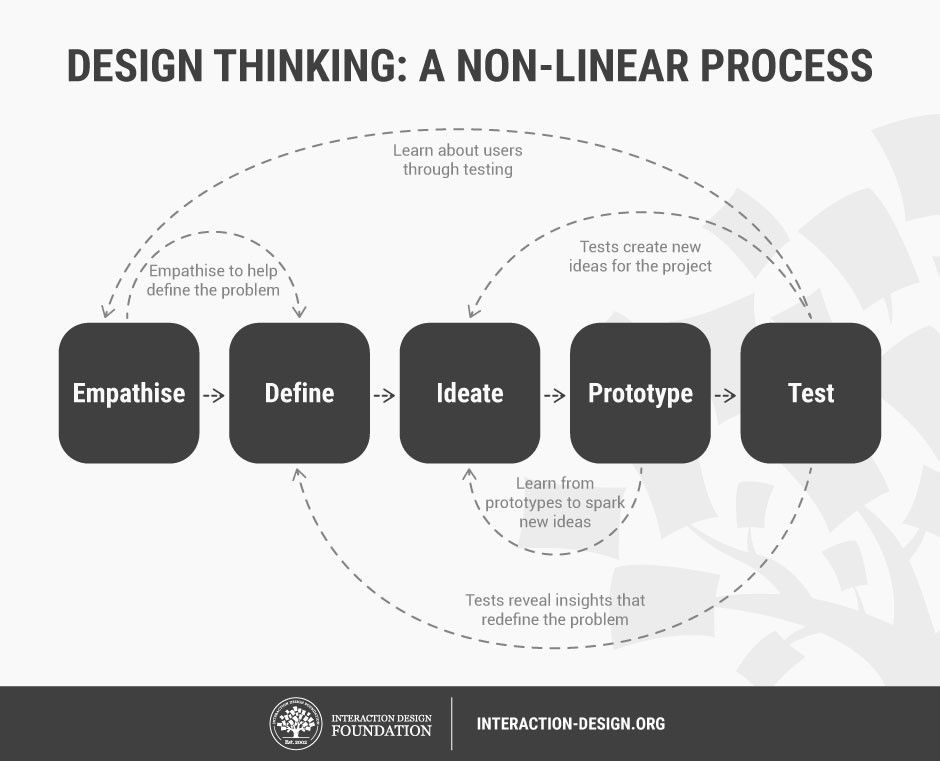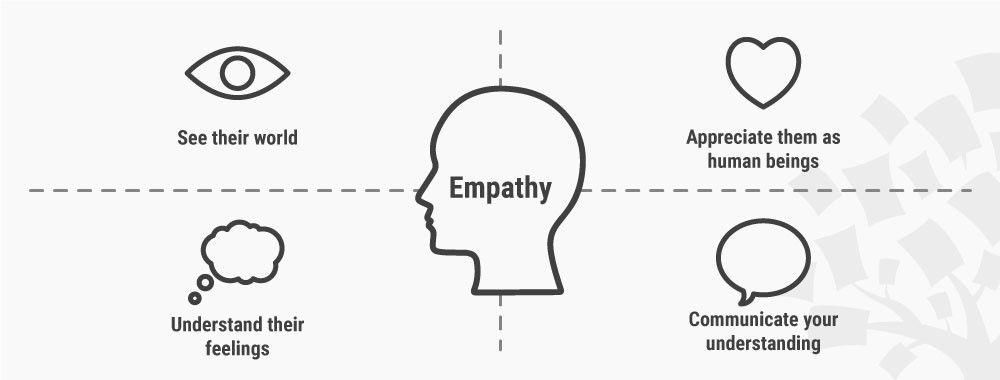Empathetic Design Thinking is about understanding users on a deeper level. It goes beyond mere observation, delving into the emotional landscape of the people for whom products and services are designed.
This approach to design is not just about crafting beautiful products; it’s about creating solutions that resonate on a human level. It asks designers to step into the shoes of users and experience their challenges and needs firsthand. Imagine a world where every product you use feels like it was made just for you.
That’s the goal of empathetic design thinking. It’s a process that starts with empathy and ends with innovation. Designers listen, observe, and immerse themselves in the experiences of others. They use this understanding to inform every decision, ensuring the final product not only solves a problem but also connects with users emotionally. In our fast-paced world, where technology often feels impersonal, empathetic design thinking brings a touch of humanity back into the things we use every day. It’s not just about making things look good – it’s about making them feel right.
The Essence Of Empathetic Design Thinking
Hey friends, today I’m going to share some insights about Empathetic Design Thinking. Imagine you’re walking in someone else’s shoes. That’s what this approach is all about. It’s about understanding people’s needs and feelings. And then… you create solutions that truly help them. It’s not just smart; it’s kind.
Bridging Empathy And Innovation
So, how do we connect caring for others with new ideas? It’s like being a detective. You watch, listen, and learn. You see what makes people happy or frustrated. Then, you think of ways to make things better. It’s not just about making cool stuff. It’s about making stuff that matters to people.
Core Principles In Action
Let’s talk about the heart of Empathetic Design Thinking. It’s built on some key ideas:
- Listen to people’s stories.
- Observe how they live and work.
- Imagine their daily challenges.
- Create solutions that fit into their lives.
I recently asked ChatGPT to help me understand a tricky topic. You know what? It broke things down and made them super clear. That’s what good design does. It makes life easier, not harder.
And remember, it’s not just about the first idea that comes to mind. It’s about finding the best one. Sometimes you have to try and fail before you succeed. But that’s okay. Every step gets you closer to a design that really helps.
Historical Context And Evolution
Hey friends, today we’re taking a stroll down memory lane. We’re going to explore how design thinking has evolved. It’s a journey from old-school methods to the caring, human-centered approach we see today. Let’s dive into the past and see how things have changed.
From Traditional To Empathetic Approaches
Design thinking wasn’t always about walking in someone else’s shoes. It used to be more about the product than the people using it. But here’s the twist: designers began to realize that to make really good stuff, they needed to understand the folks who would use it. And that’s when things got interesting.
Imagine this. In the old days, you made a chair. It was a nice chair. But sometimes, people didn’t find it comfy. Why? Because maybe the designer didn’t think about different kinds of people sitting on it. Fast forward to now, and it’s a whole new ball game. We’ve got designers asking questions, watching, and listening to the people who will use that chair. That’s empathetic design thinking for you.
Key Milestones In Design Thinking
Let’s talk about some big moments in design thinking. It’s like a highlight reel of the design world’s greatest hits.
- Problem-solving roots: It all started with figuring out how to solve problems. Simple, right? But super important.
- Adding creativity: Then came the idea of mixing in creativity. Not just solving problems, but doing it with a bit of flair.
- The human touch: This is where it gets good. Designers began focusing on real people and their needs. It’s like giving a warm hug to the whole process.
Each step brought us closer to understanding that design is not just about looks or function. It’s about making life better for people. Because when you get right down to it, that’s what really matters.
Empathy In Design: More Than A Buzzword
Hey friends! Let’s dive into why empathy is so crucial in design. It’s not just a fancy word that people throw around. It’s the heart of creating products that truly make a difference in people’s lives. Imagine walking a mile in someone else’s shoes. That’s what empathetic design is all about. It’s seeing the world through the eyes of your users.
Understanding User Needs
Getting to the core of what people really need isn’t easy, but it’s essential. Here’s how you do it:
- Listen: Really hear what people are saying.
- Observe: Look at how they use products and face challenges.
- Feel: Connect with their emotions and experiences.
Think of it this way. If you were designing a cup, wouldn’t you want to know if your user had a hard time holding regular cups? That’s empathy. You’re not just making any cup. You’re making a cup that feels right in their hand.
Real-world Examples
Let’s look at some real-life cases where empathy made all the difference:
- Accessible Tech Gadgets: Companies are now creating gadgets that everyone can use, including people with disabilities. They listened and understood the needs.
- Apps for Mental Health: Developers are making apps that truly understand the struggle with mental health. They offer a helping hand, not just a tool.
These examples show that when you design with empathy, you’re not just making things. You’re making things better for people. And that’s a game everyone wins.
In conclusion, empathy in design isn’t just a trend. It’s the way forward. By understanding user needs and looking at real-world examples, we see the power of designing with a heart. So, next time you sit down to create something, remember to put on those empathy shoes. Your users will thank you.

Credit: www.linkedin.com
Steps To Implement Empathetic Design Thinking
Empathetic Design Thinking involves stepping into users’ shoes to understand their needs. It starts with observing and listening to create solutions that truly resonate.
Understanding the needs and emotions of users is at the heart of empathetic design thinking. This approach shapes products that truly resonate with the target audience. Let’s break down the process into actionable steps.
Identifying The Problem
Start by pinpointing the issue. Look at the situation from the user’s perspective. What challenges do they face? Keep user needs at the forefront.
Gathering Insights
Next, collect user data. Engage with real people. Observe their behaviors. Listen to their stories. This step is crucial to uncover deeper needs.
Ideation And Prototyping
Now, brainstorm solutions. Think creatively. Sketch out ideas. Build simple prototypes. This phase is about exploring possibilities.
Testing And Iteration
Finally, test with users. Get feedback. Learn what works and what doesn’t. Refine your design. Repeat this cycle until the solution feels right.
Tools And Techniques For Empathetic Design
Empathetic Design is key to creating products that resonate with users. It involves stepping into their shoes and understanding their experiences. The right tools and techniques can bring a user’s needs and emotions into focus. This way, designers craft solutions that truly connect.
User Interviews And Surveys
Gathering insights starts with asking questions. User interviews dig deep into needs and frustrations. Surveys reach more people quickly. Both methods reveal the human behind the data.
Personas And Empathy Maps
Personas bring data to life, turning numbers into relatable characters. Empathy maps go further. They chart what users think, feel, see, and do. Together, they build a clear picture of the user’s world.
Journey Mapping
Every user takes a journey with a product. Journey maps track each step, highlighting pain points and delights. This map guides designers to create more intuitive and enjoyable experiences.

Credit: www.interaction-design.org
Challenges And Solutions In Empathetic Design Thinking
Hey friends! Today, we’re diving into the world of Empathetic Design Thinking. It’s all about understanding the feelings and needs of the people we design for. But, guess what? It’s not always a walk in the park. Let’s talk about the ups and downs and how to make things smoother.
Common Pitfalls
Even the best ideas can face challenges. In Empathetic Design Thinking, we often stumble upon a few roadblocks:
- Getting too attached to our first idea.
- Misunderstanding what users really need.
- Overlooking feedback because it doesn’t fit our vision.
It’s like trying to fit a square peg in a round hole. Just doesn’t work.
Overcoming Bias And Assumptions
This is a biggie. We all see the world in our own unique way, which means we carry biases and make assumptions. But in Empathetic Design Thinking, we need to step outside our own shoes. Here’s how:
- Listen more than you talk. Hear what people are really saying.
- Ask questions. And then ask some more. Get to the heart of what users need.
- Challenge your first idea. Maybe your second or third idea is the winner.
Imagine you’re a chef trying to cook a meal for someone with a taste palette different from yours. You won’t know what they love until you ask and experiment.
Remember, friends, Empathetic Design Thinking is a journey. It’s about making mistakes, learning, and growing. I once thought I had the perfect design. Turned out, I was way off. But by listening and adapting, I found a solution that truly resonated. That’s the beauty of this process.
So, let’s keep our minds open, embrace the challenges, and work towards solutions that make a real difference. Who knows? The next great idea might just be around the corner.
Success Stories: Transformative Impact Of Empathetic Design
Discover how empathetic design thinking reshapes products and services, focusing on real human needs. These success stories showcase the powerful results of putting user experience first.
Empathetic Design shapes products and services that truly resonate with users. By understanding people’s feelings, designers create solutions that make a real difference. This approach has led to impressive success stories across various sectors. Empathetic Design not only meets user needs but often exceeds their expectations. Let’s explore some transformative impacts of this human-centered approach.
Healthcare Innovations
Empathetic Design in healthcare leads to tools that patients and doctors love. For instance, patient monitoring devices have become more comfortable and less intrusive, thanks to empathy-driven design. This shift improves patient care and simplifies medical procedures. Devices now feel like they were made just for the user, easing stress and promoting healing.
Revolutionizing Consumer Products
In the consumer space, empathy makes products that fit into daily life seamlessly. Think of ergonomic kitchen tools that prevent strain or apps that simplify shopping. These products stem from a deep understanding of challenges in everyday tasks. Users get solutions that feel tailor-made, enhancing satisfaction and loyalty.
Impact On Public Services
Public services have also felt the positive effects of Empathetic Design. From easier-to-navigate government websites to public transport systems that cater to all, this approach has been pivotal. It ensures services are accessible to everyone, including those with disabilities. Communities thrive when public services consider everyone’s needs.

Credit: www.interaction-design.org
Future Directions In Empathetic Design Thinking
Hey friends, let’s dive into the future of empathetic design thinking. This approach isn’t just about making things look good. It’s about understanding people and solving their problems. The future looks bright, and it’s full of new ideas that will make products better for everyone. Here are some paths we’ll explore:
Integrating Advanced Technologies
Imagine a world where products know how you feel. Sounds like science fiction, right? But it’s becoming real. Here’s what’s coming:
- Smart tools that learn from you and adapt to your needs.
- Devices that can read your emotions and respond to them.
- Virtual reality that lets you test products before they’re made.
Sustainable And Inclusive Design
Good design is for everyone and doesn’t hurt the planet. Here’s how we’re making that happen:
- Using eco-friendly materials that reduce waste.
- Creating designs that work for all people, no matter their ability.
- Thinking long-term to make products that last longer.
Educational Initiatives
Learning is the key to a better future. We’re seeing more:
| Programs | Focus |
|---|---|
| Workshops | Hands-on design practice |
| Online Courses | Teaching design thinking |
| School Programs | For young creators |
These are just a few steps on the journey of empathetic design thinking. I recently asked ChatGPT to create a design for me. The result? A design that not only looked great but also felt right. That’s the power of empathy in design. As we move forward, let’s keep our hearts open to new ideas and our minds ready for innovation.
Conclusion
Empathy in design thinking bridges gaps between products and people. It’s crucial for creating solutions that resonate. Remember, understanding user needs leads to better innovation. Adopting an empathetic approach in design ensures a deeper connection with your audience. It’s not just about looks; it’s about feelings and functionality.
Embrace this mindset and watch your creations thrive. Let’s put people first in our design journey. Together, we’ll craft experiences that truly matter.
Related Article: Interior Design Mistakes to Avoid for Chic Home Decor
- Best Electric Pressure Washers for Powerful and Efficient Home Cleaning - October 22, 2025
- Best Riding Lawn Mowers for Powerful and Efficient Lawn Care - September 11, 2025
- Best Cheap Smart Door Lock: Enhance Home Security with Ease - August 21, 2025



